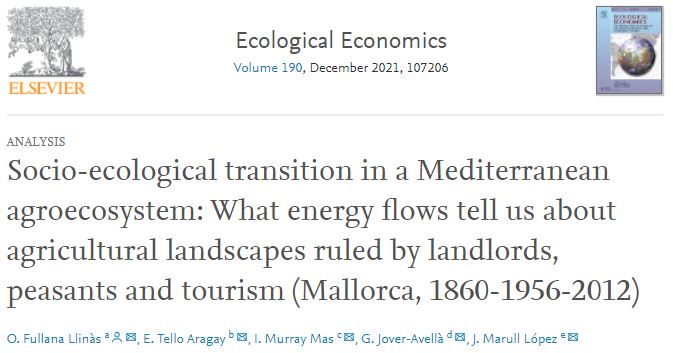Fullana, O., Tello, E., Murray, I. et al. 2021. «Socio-ecological transition in a Mediterranean agroecosystem: What energy flows tell us about agricultural landscapes ruled by landlords, peasants and tourism (Mallorca, 1860-1956-2012)». Ecological Economics 190 (December): 107206
Using several energy returns on investment indicators (multi-EROI), this article analyses the socioecological transition of an agroecosystem in the western Mediterranean on the island of Mallorca (Spain) over a period of 150 years which saw a change from traditional organic farming to a fossil fuel-based system of agriculture. This circular bioeconomic analysis evaluates the agroecosystem’s capacity to produce goods by reproducing itself in 1860, 1956 and 2012. In 1860 land and livestock were mostly in the hands of a few landowners, who kept agroecosystems away from the full productive capacity of traditional organic farming so as to increase land rents by lowering wages. The bankruptcy of these large estates increased peasant access to land at the end of the nineteenth and the first third of the twentieth centuries. Peasant farms were mainly solar-based and combined polyculture with a large number of small flocks, thus creating complex and attractive Mediterranean biocultural landscapes with higher EROIs. By 1956, these had practically reached the limits of traditional organic farming and early became a residual activity within the tourism specialization of the economy. As everywhere, conventional farming reduced agrarian eco-efficiency through production increases achieved at the cost of greater dependence on external fossil fuel-based inputs, a loss of biophysical circularity and lower EROIs. In Mallorca, however, this took place at the same time as agriculture was subsumed by the tourist economy, leading to a more partial and less widespread adoption of Green Revolution techniques than in other parts of Spain. Although agroecosystem live funds were undermined and the reproduction of Mallorcan biocultural landscapes was placed at risk, an important heritage of biocultural peasant agriculture still survives as a resource for the future.

